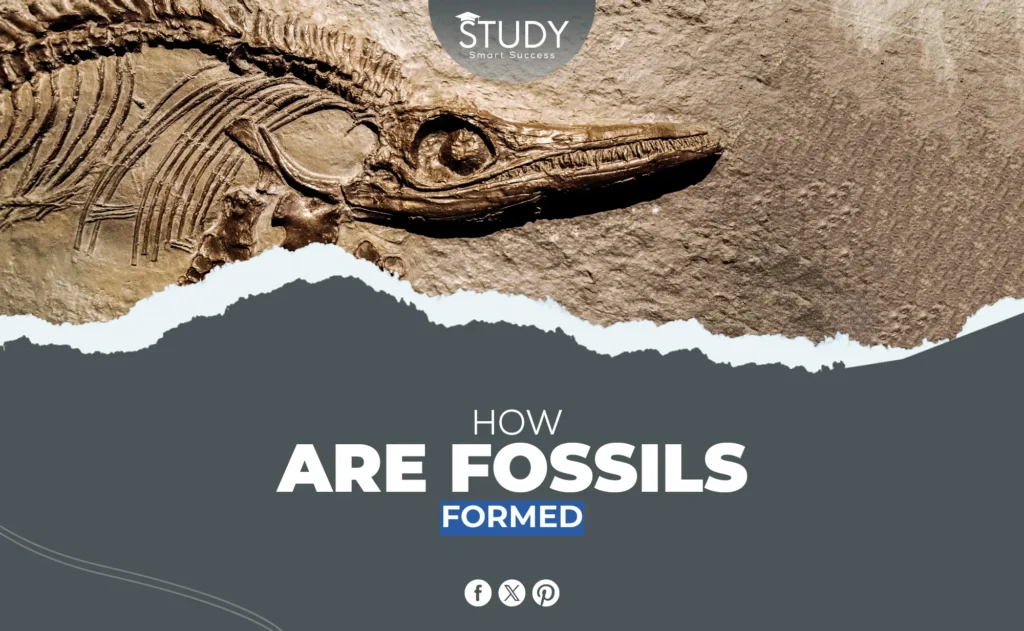Introduction
Fossils are nature’s way of keeping history. They show us how ecosystems worked in the past, how animals lived and died, and how life itself has changed over time. If you’re a student, a science buff, or a geology fan, you need to know how fossils form to understand the past that is written in sedimentary rocks.
This blog will talk about the steps fossils go through to form, the different kinds of fossils, the role of geological rocks, and the ways that palaeontologists today find these old gems. There is also a useful table that lists the different kinds of fossils and how they form.
What Is Fossilization?
Fossilization is the natural process that preserves evidence of ancient organisms, either as physical remains or traces of their activity. This process spans millions of years and traps information about past life in the earth’s crust. Importantly, not all organisms fossilize, making fossils rare and exceptionally valuable for understanding history.
Types of Fossils
Before we break down the fossilization stages, here’s an overview of the main fossil types:
- Body Fossils: Physical remnants like bones, shells, or teeth.
- Trace Fossils: Evidence of behavior, such as footprints or burrows.
- Chemical Fossils: Molecular traces like organic compounds.
- Imprints/Molds: negative impressions left in sediment.
The Fossilization Process
1. Death of an Organism
When an individual dies, the process starts. Fossilization usually works best for hard parts of animals, like bones, shells, and teeth, since these don’t break down as quickly. For soft tissues to fossilize, very few factors must be present.
2. Burial in Sediment
Species must be quickly hidden under layers of soil, like sand, mud, or volcanic ash, in order to turn into a fossil. This grave keeps scavengers from eating the body parts and slows the decay that happens when air gets to them. As the main “record-keepers” for fossils, sedimentary rocks are very important here.
3. Sediment Compaction and Mineralization
Over millions of years, layers of sand build up and pack down the hidden remains. This makes a lot of pressure and starts the hardening process. Minerals such as silica, calcite, and pyrite harden the remains into fossils by replacing the biological matter with them.
4. Formation of Sedimentary Rock
When the silt is packed down, it forms sedimentary rock, which is nature’s way of protecting fossils. Sedimentary rocks are very important for fossils because their stacked structure shows how Earth’s past unfolded over time. Sandstone, limestone, and shale are some important types.
5. Exhumation (Erosion and Discovery)
Lastly, the fossils are exposed by weathering, geological action, or human activity. This is when paleontologists can find, study, and figure out how old the bones are.
Table of Fossil Types and Their Formation
|
Fossil Type |
Formation Process |
Typical Examples |
|---|---|---|
|
Body Fossils |
Hard parts preserved through mineralization |
Bones, teeth, shells |
|
Trace Fossils |
Impressions or traces of activity buried in sediment |
Footprints, burrows, feces |
|
Imprints/Molds |
Negative impressions left in sediment, later hardened |
Leaves, shells’ molds |
|
Chemical Fossils |
Molecular remnants of organic compounds preserved |
Lipids, pigments |
The Role of Sedimentary Rocks in Fossil Formation
Earth’s fossils have been safely stored in sedimentary rocks for millions of years. Layers of these rocks form, with remains from earlier times found at the bottom. What kind of solid rock it is also affects how well fossils are preserved. As an example:
- Limestone: Excellent for preserving aquatic fossils.
- Sandstone: Forms molds and casts but might lose delicate details.
- Shale: Captures fine details due to its fine-grained texture.
How Do Paleontologists Find and Study Fossils?
- Fieldwork and Excavation – Scientists survey sedimentary rock formations to uncover fossils. Technologies like ground-penetrating radar aid in finding buried specimens.
- Fossil Preparation – Fossils are carefully extracted using tools like brushes and chisels to preserve their integrity.
- Carbon Dating – To estimate the fossil age, scientists use methods like radiocarbon or uranium-lead dating.
- Laboratory Analysis – Chemical and morphological studies reveal more about the fossil’s history and the environment it came from.
Why Do Some Organisms Fossilize and Others Don’t?
Unfortunately, only a tiny percentage of organisms ever fossilize. Key factors include:
- Hardness: Soft-bodied organisms are less likely to fossilize.
- Rapid Burial: A quick burial in sediment is essential.
- Environmental Conditions: Wet, low-oxygen environments favor fossilization, while acidic or oxygen-rich conditions hinder it.
Fascinating Fossil Finds
Though fossils are relatively rare, some discoveries are groundbreaking.
- Lucy (Australopithecus afarensis): One of humanity’s earliest ancestors.
- Fossilized Amber: Preserved ancient insects and even dinosaur-era feathers.
- The Burgess Shale: A treasure trove of soft-bodied organisms.
Each fossil has its unique story, offering clues about evolution, extinction, and climates of the past.
How Can You Learn More About Fossils?
Becoming a fossil enthusiast is easier than you think:
- Visit natural history museums to see fossils up close.
- Join fossil hunting groups for hands-on experience.
- Explore online courses on palaeontology to deepen your knowledge.
- Traceback Earth’s timeline by studying sedimentary rock layers if you’re exploring on your own.
Unearth the Past Today
Fossils are more than just pieces of the past stuck in rock. They show how Earth has changed over time and the animals that have lived, swum, or flown across it. Learning about how fossils are made helps us appreciate how nature tells stories.
Keep reading our blog for more interesting science posts, or get in touch with paleontological groups in your area to start your own journey into Earth’s past! What other types of fossils have been discovered? How can we use fossils to understand Earth’s history? These are just some questions that you may explore as you continue your learning journey about fossils and the fascinating world of paleontology. Remember, there is always more to discover and uncover in the vast field of science. Happy fossil hunting!


